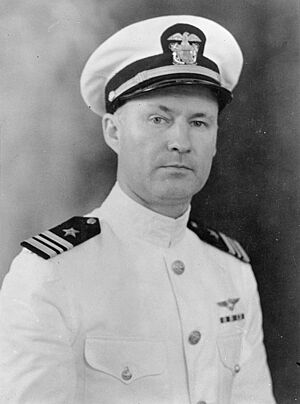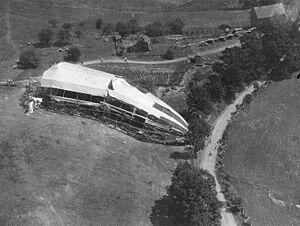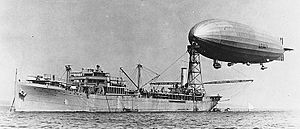Charles E. Rosendahl facts for kids
Quick facts for kids
Charles Emery Rosendahl
|
|
|---|---|

Lt. Cmdr. Charles Rosendahl, USN, circa 1930
|
|
| Nickname(s) | Rosey |
| Born | May 15, 1892 Chicago, Illinois |
| Died | May 17, 1977 (aged 85) Naval Hospital Philadelphia, Pennsylvania |
| Allegiance | United States |
| Service/ |
|
| Years of service | 1910–1946 |
| Rank | |
| Commands held | USS Claxton USS Los Angeles Rigid Airship Training and Experimental Squadron USS Akron NAS Lakehurst USS Minneapolis Naval Airship Training Command |
| Battles/wars | Mexican Revolution World War I World War II |
| Awards | Navy Cross Distinguished Service Medal Distinguished Flying Cross |
Charles Emery Rosendahl (May 15, 1892 – May 17, 1977) was a brave U.S. Navy officer. He became a vice admiral, a very high rank. He was also a big supporter of airships, which are like giant balloons that can fly.
Contents
Life Story
Charles Rosendahl was born in Chicago, Illinois. His family later moved to Kansas and Texas. In 1910, he joined the Naval Academy. After graduating in 1914, he became an ensign.
His first job was on the ship West Virginia (ACR-5). This was during a time of trouble in Mexico. He then served on other ships like the Oregon (BB-3) and Cleveland (C-19). During World War I, he helped escort ships carrying troops and supplies to Europe. He was promoted to lieutenant (junior grade) and then lieutenant.
In 1918, Rosendahl became an engineering officer. He helped get the new destroyer McKean (DD-90) ready for duty. He later worked on other destroyers, making sure they were ready for the fleet. In 1921, he took command of the destroyer Claxton (DD-140). After that, he became an instructor at the Naval Academy.
Flying High with Airships
The Navy was looking for volunteers to work with large airships. Rosendahl decided to try it. In 1923, he went to Naval Air Station Lakehurst, New Jersey, for training. He became a naval aviator in 1924.
He worked on the airship Shenandoah (ZR-1). In 1925, the Shenandoah broke apart in the air. Rosendahl bravely brought the front part of the airship safely to the ground. For this, he received the Distinguished Flying Cross.
From 1926, he was the second-in-command, then the main commander, of the airship Los Angeles (ZR-3). He flew many missions for training and testing. The Los Angeles also helped search for planes that went missing while trying to fly across the Atlantic Ocean.
In 1928, Rosendahl flew the Los Angeles to meet the aircraft carrier Saratoga (CV-3). The airship even connected to the ship's back to refuel. He also did tests with the airship tender Patoka (AO-9) during long flights.
Rosendahl traveled to Britain and Germany to learn about their airships. In October 1928, he was on the German airship Graf Zeppelin when it made its first flight across the Atlantic.
In 1929, he became the commander of the Airship Training Squadron at Lakehurst. He also flew around the world on the Graf Zeppelin as an observer. In 1931, he commanded the new airship Akron (ZRS-4). They even tried using it as a flying aircraft carrier.
From 1932 to 1934, Rosendahl served on battleships and cruisers. In 1934, he took command of NAS Lakehurst. He was promoted to commander in 1935.
He also observed flights on the German airship Hindenburg in 1936. On May 6, 1937, he was in command at Lakehurst when the Hindenburg caught fire. He led the rescue efforts. He later said he thought everyone would be killed by an explosion.
In 1938, he left Lakehurst and became an officer on the light cruiser Milwaukee (CL-5). In 1940, he started working on airship evaluations for the Secretary of the Navy. He was promoted to captain. He also helped choose locations for new airship stations.
World War II Hero
In 1942, Rosendahl took command of the heavy cruiser Minneapolis (CA-36). During the Battle of Tassafaronga in November 1942, his ship was hit by torpedoes. It lost 80 feet of its front and had serious damage. But Rosendahl managed to keep the ship afloat and get it to safety. For this brave action, he received the Navy Cross.
In 1943, he returned to NAS Lakehurst. He became the Chief of Naval Airship Training Command. He was promoted to rear admiral. He stayed in this role through World War II. He retired from the Navy in 1946 and was promoted to vice admiral.
After retiring, Rosendahl worked as an aviation consultant. He was also a vice-president for an aircraft company. In 1953, he helped lead a group that studied air travel problems in New York.
He retired to Toms River, New Jersey, in 1960. He wanted to write and help create an airship museum at Lakehurst. The Navy gave land for the museum, but the group could not raise enough money.
The U.S. Navy stopped using airships in 1962. Rosendahl was on the last flight of a Navy blimp. He passed away on May 17, 1977.
Personal Life
Charles Rosendahl met Jean Wilson on a train in 1932. They were married in December 1934.
Groups He Belonged To
Rosendahl was a member of many important groups, including:
- A Fellow of the Institute of the Aeronautical Sciences
- A member of the Clifford B. Harmon Trust
- Past President of the Wings Club of New York
- A founder of the Army-Navy Country Club in Washington, D.C.
- A long-time member of the American Legion
- The Explorers' Club
Awards and Honors
Civilian Awards
Charles Rosendahl received many honors outside the military:
- He was named an Elder Statesman of Aviation by the National Aeronautic Association.
- He won four Harmon Trophies for his work with airships.
- He received the Frank M. Hawks Award.
- In 1980, he was added to the Aviation Hall of Fame and Museum of New Jersey.
He also received two honorary degrees from universities.
Military Awards
Here are the ribbons for Vice Admiral Charles E. Rosendahl's military awards:
 |
|||
| Naval Aviator Badge | |||||||||||||
| 1st Row | Navy Cross | Navy Distinguished Service Medal | Distinguished Flying Cross | ||||||||||
|---|---|---|---|---|---|---|---|---|---|---|---|---|---|
| 2nd Row | Mexican Service Medal | World War I Victory Medal with Fleet Clasp | American Defense Service Medal with Atlantic Fleet Clasp | ||||||||||
| 3rd Row | Asiatic-Pacific Campaign Medal with one Service star | American Campaign Medal | World War II Victory Medal | ||||||||||





